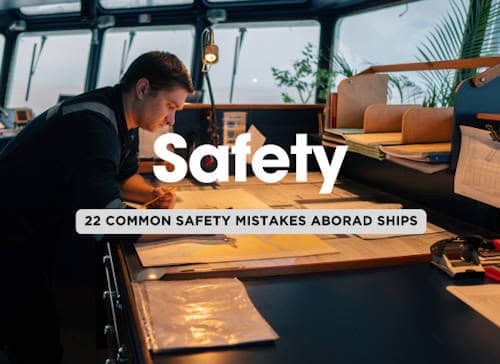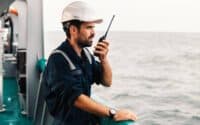22 Common Safety Mistakes on Commercial Ships and How to Avoid Them

Ensuring safety aboard commercial ships is critical to protecting the crew, cargo, and vessel from avoidable accidents. However, despite rigorous training and safety protocols, certain common mistakes can still slip through the cracks, leading to potential risks. This guide highlights 22 of the most common safety mistakes found on commercial ships, along with actionable tips on how to avoid them. From overlooked maintenance tasks to complacency during drills, these insights aim to foster a proactive safety culture onboard.

1. 🚧 Inadequate Safety Drills
Mistake: Regular safety drills are essential for keeping crew prepared for emergencies. However, some ships conduct drills infrequently or skip them altogether, which can leave crew members unprepared in a real crisis.
Solution: Conduct safety drills every month, covering various scenarios like man-overboard, fire, and abandon-ship procedures. Ensure each crew member knows their role and location during these drills.
- Key Tip: Rotate drill scenarios to keep preparedness high.
- Recommended Frequency: Monthly
- Related Equipment: Lifeboats, life jackets, fire extinguishers
2. 🧰 Neglecting Routine Equipment Inspections
Mistake: Failing to perform routine checks on safety and operational equipment can lead to malfunctions at critical times. This is especially risky for life-saving equipment, which must be in top condition.
Solution: Implement a monthly checklist to inspect all life-saving and emergency equipment, such as lifeboats, fire extinguishers, and communication tools. Assign designated crew members to oversee each inspection area.
- Key Tip: Log each inspection and note any necessary repairs.
- Inspection Checklist: Life vests, extinguishers, lifeboats
- Frequency: Monthly, with a quick check every voyage
3. 🔒 Improper Storage of Hazardous Materials
Mistake: Hazardous materials, such as flammable liquids or chemicals, are sometimes stored in unsuitable areas or without adequate labeling, increasing the risk of fire or chemical exposure.
Solution: Store all hazardous materials in designated, well-ventilated areas. Ensure each item is clearly labeled, and provide crew members with the necessary safety gear when handling these materials.
- Key Tip: Regularly review the Material Safety Data Sheets (MSDS) for each substance onboard.
- Storage Requirements: Labeled storage area, ventilation
- Recommended Safety Gear: Gloves, goggles, respirators
4. 📋 Overlooking Weather Conditions and Route Planning
Mistake: Some crews may underestimate the importance of adjusting routes based on updated weather forecasts, leading to navigational risks and potential accidents.
Solution: Always monitor weather conditions in real-time and adjust routes as necessary. Use reliable weather forecasting tools, and ensure all bridge officers are trained to interpret forecast data.
- Key Tip: Plan for alternative routes in case of severe weather.
- Required Tools: Satellite weather service, route planning software
- Emergency Preparation: Brief crew on potential route changes and emergency procedures
5. 🕹️ Failure to Secure Loose Cargo
Mistake: Unsecured cargo can shift during rough seas, causing damage to the ship, endangering crew members, and potentially leading to cargo loss.
Solution: Secure all cargo according to safety standards, using lashing and securing devices appropriate for each type of load. Regularly check lashings and reinforce them before expected rough weather.
- Key Tip: Conduct a final check of all cargo securing before setting sail.
- Securing Equipment: Lashing straps, cargo nets, stoppers
- Inspection Frequency: Prior to each departure and during voyages
6. 🔋 Not Testing Emergency Power Systems Regularly
Mistake: Infrequent testing of emergency generators and backup power systems can lead to critical power failures during emergencies, putting the vessel and crew at risk.
Solution: Test all emergency power systems weekly to ensure they function properly in case of a primary power loss. Include emergency lighting and communications systems in these checks.
- Key Tip: Schedule power tests as part of weekly maintenance routines.
- Equipment to Test: Emergency generators, lighting, backup batteries
- Testing Frequency: Weekly
7. 🚪 Ignoring Proper Ventilation in Confined Spaces
Mistake: Confined spaces like storage tanks, engine rooms, and cargo holds can accumulate toxic gases if not properly ventilated, posing health risks to crew members.
Solution: Ensure all confined spaces are ventilated before entry, and use gas detection devices to test for hazardous gases. Always follow confined space entry protocols and have a safety observer present.
- Key Tip: Require all crew members to wear portable gas detectors when entering confined spaces.
- Ventilation Equipment: Portable fans, gas detectors
- Entry Procedure: Test air quality and ensure observer presence
8. ⚙️ Poor Maintenance of Fire Extinguishing Systems
Mistake: Fire extinguishing systems, including sprinklers and extinguishers, may not be maintained as required, leading to malfunctions during fire emergencies.
Solution: Regularly inspect and maintain all fire extinguishing systems. Replace expired extinguishers and ensure that automated fire suppression systems are in working order.
- Key Tip: Perform monthly checks on all fire suppression equipment and log maintenance activities.
- Maintenance Tools: Pressure gauge, extinguisher refills
- Inspection Frequency: Monthly, with detailed annual inspection
9. 💧 Improper Handling of Ballast Water
Mistake: Failure to manage ballast water correctly can destabilize the ship, increase the risk of invasive species transfer, and result in non-compliance with environmental regulations.
Solution: Follow Ballast Water Management (BWM) protocols, regularly inspect ballast tanks, and use treatment systems to filter out harmful organisms. Ensure that all ballast water handling is recorded in the BWM logbook.
- Key Tip: Train crew members on ballast water handling procedures and compliance requirements.
- Required Equipment: Ballast water treatment systems, BWM logbook
- Inspection Frequency: Before departure and as per BWM regulations
10. 🧯 Inadequate Training on Fire Response
Mistake: Some crew members may lack adequate training in fire response techniques, reducing the effectiveness of firefighting efforts during an onboard fire.
Solution: Conduct comprehensive fire response training, covering the use of fire extinguishers, fire hoses, and breathing apparatus. Regularly run fire drills to reinforce skills and ensure all crew members are prepared.
- Key Tip: Include fire response training as part of onboarding and quarterly refresher courses.
- Essential Training Equipment: Fire extinguishers, fire hoses, breathing apparatus
- Training Frequency: Quarterly, with additional onboard practice drills
11. 📝 Failing to Update the Ship's Safety Management System (SMS)
Mistake: An outdated Safety Management System (SMS) can leave the crew uninformed about current safety practices, protocols, and regulatory changes.
Solution: Regularly review and update the SMS to reflect current regulations and best practices. Ensure all crew members are familiar with SMS procedures and understand their roles in maintaining ship safety.
- Key Tip: Assign an officer to oversee SMS updates and crew training.
- Required Documentation: SMS manuals, safety logs, regulatory updates
- Review Frequency: Every six months or after regulatory changes
12. ⚓ Neglecting Anchoring Procedures in High-Traffic Areas
Mistake: Improper anchoring practices in high-traffic zones or near shorelines can lead to collisions or grounding, risking crew safety and potential damage to the vessel.
Solution: Follow strict anchoring procedures, ensuring the anchor is properly deployed and secured. Use updated charts to identify safe anchoring locations, and communicate with port authorities when anchoring in busy areas.
- Key Tip: Assign a crew member to monitor anchor stability, especially in rough waters or high-traffic zones.
- Essential Tools: Anchor windlass, updated nautical charts
- Monitoring Frequency: Constantly while anchored, especially in crowded waters
13. 🚫 Improper Use of Personal Protective Equipment (PPE)
Mistake: Failing to wear or improperly using PPE increases the risk of injury, especially during maintenance, handling hazardous materials, or operating machinery.
Solution: Ensure that all crew members are trained in the correct use of PPE and that they wear it at all times when handling potentially dangerous tasks. Conduct regular PPE checks to ensure equipment is in good condition.
- Key Tip: Place visible reminders and signage in work areas to reinforce PPE use.
- Required PPE: Hard hats, gloves, safety goggles, respirators
- Inspection Frequency: Weekly check of PPE condition and availability
14. 🧑🔧 Inadequate Lockout-Tagout (LOTO) Procedures
Mistake: Skipping lockout-tagout procedures during equipment maintenance can lead to accidental equipment startup, causing serious injuries.
Solution: Implement strict lockout-tagout protocols for all maintenance and repair activities. Ensure only authorized personnel remove lockout devices and conduct training on proper LOTO practices.
- Key Tip: Assign a dedicated safety officer to oversee LOTO compliance.
- Essential Tools: Lockout devices, tags, and safety padlocks
- Training Frequency: Annually, with on-the-job refreshers
15. 🚨 Delayed Emergency Signal Response
Mistake: Hesitating to activate emergency signals or communicate an emergency can lead to delayed responses, worsening the situation and increasing risks for the crew.
Solution: Train all crew members to recognize situations requiring emergency signals and encourage prompt action without delay. Practice using emergency signals during drills to build confidence.
- Key Tip: Ensure that emergency alarms are well-marked and that every crew member knows how to activate them.
- Equipment: Emergency alarms, radios, communication systems
- Practice Frequency: Bi-annual emergency drills
16. 🧼 Slippery Decks and Lack of Anti-Slip Measures
Mistake: Failing to maintain anti-slip surfaces or address spills quickly can lead to slips and falls, one of the most common injuries aboard ships.
Solution: Use anti-slip mats or coatings on deck surfaces, and implement immediate spill clean-up procedures. Conduct regular inspections of decks to identify and address slipping hazards.
- Key Tip: Assign crew members to inspect high-traffic areas regularly and clean up spills immediately.
- Anti-Slip Solutions: Anti-slip mats, deck coatings, warning signage
- Inspection Frequency: Daily, with spot checks during each shift
17. 🔒 Inadequate Securing of Open Hatches and Doors
Mistake: Leaving hatches, doors, or other openings unsecured can create fall hazards and allow water ingress, posing a risk to both crew safety and ship stability.
Solution: Ensure all hatches and doors are securely closed and locked when not in use, especially in rough seas. Conduct regular checks to confirm that no openings are left unsecured.
- Key Tip: Designate specific crew members to check all hatches and doors before departure and during adverse weather.
- Required Equipment: Locking mechanisms, signage to indicate open/closed status
- Inspection Frequency: Daily and during each shift
18. 🚿 Lack of Proper Sanitation and Hygiene Practices
Mistake: Inadequate sanitation can lead to illnesses on board, which is particularly risky given the close quarters of a ship's crew and limited medical resources.
Solution: Enforce strict hygiene practices, such as regular hand washing, sanitation of common areas, and safe food handling procedures. Provide ample supplies of sanitation products and encourage their use.
- Key Tip: Set a regular cleaning schedule for high-contact areas.
- Sanitation Supplies: Hand sanitizers, disinfectants, antibacterial wipes
- Cleaning Frequency: Daily for common areas, with periodic deep cleaning
19. 🧪 Incorrect Handling and Disposal of Waste and Chemicals
Mistake: Mishandling or improperly disposing of hazardous waste, including chemicals and fuel residues, can lead to environmental damage, health risks, and regulatory violations.
Solution: Follow international guidelines for waste handling and disposal, such as MARPOL regulations. Train crew members on safe handling practices and maintain a waste log to track disposal.
- Key Tip: Store hazardous waste separately from other waste to prevent contamination.
- Required Equipment: Waste containment units, chemical disposal containers
- Inspection Frequency: Weekly, with continuous monitoring
20. ⛓️ Failure to Conduct Regular Mooring Inspections
Mistake: Overlooking the inspection of mooring lines, winches, and other anchoring equipment can lead to line failures or accidents when docking or undocking.
Solution: Inspect all mooring equipment regularly for wear and tear, and replace lines and components as needed. Train crew members on safe mooring practices to prevent incidents.
- Key Tip: Inspect mooring lines closely before arrival at and departure from port.
- Inspection Tools: Line tension meters, visual inspection guides
- Inspection Frequency: Before and after each mooring operation, with monthly equipment checks
21. 🌊 Overlooking Lifeboat Maintenance and Readiness
Mistake: Lifeboats are critical for emergencies, yet they are sometimes neglected during routine maintenance checks, which can lead to malfunctions when they’re most needed.
Solution: Regularly inspect lifeboats for wear and test their deployment systems. Ensure that lifeboats are stocked with essential supplies and easily accessible during emergencies.
- Key Tip: Schedule a monthly lifeboat check, including a quick launch test to ensure functionality.
- Essential Equipment: Lifeboat release mechanisms, survival gear
- Inspection Frequency: Monthly, with an annual thorough inspection
22. 🕒 Failing to Monitor Crew Working Hours to Prevent Fatigue
Mistake: Overworking crew members without adequate rest can lead to fatigue, which increases the likelihood of accidents and reduces response effectiveness during emergencies.
Solution: Adhere to regulated work-rest schedules, ensuring that all crew members receive sufficient breaks and rest time. Implement a rotation system to reduce fatigue, especially for those with high-responsibility roles.
- Key Tip: Use a crew scheduling tool to monitor and manage work-rest hours effectively.
- Tools for Monitoring: Crew scheduling software, rest logbooks
- Rest Break Frequency: Per regulatory guidelines, typically a minimum of 10 hours of rest in 24 hours
By recognizing and addressing these common safety mistakes, shipowners and crews can significantly improve safety standards on board. Preventative measures, regular training, and adherence to safety protocols not only reduce the risk of accidents but also foster a culture of awareness and responsibility among the crew. Prioritizing safety across all operations—from routine inspections to emergency preparedness—ensures a safer, more efficient voyage for everyone involved.
Table Summary
| ShipUniverse: 22 Common Safety Mistakes on Commercial Ships and How to Avoid Them | ||||
|---|---|---|---|---|
| Safety Mistake | Solution | Key Tip | Essential Equipment | Inspection/Action Frequency |
| Inadequate Safety Drills | Conduct regular safety drills for all scenarios. | Rotate drill scenarios monthly. | Lifeboats, life jackets, fire extinguishers | Monthly |
| Neglecting Routine Equipment Inspections | Implement a checklist for equipment checks. | Log each inspection for tracking. | Life vests, extinguishers, lifeboats | Monthly, with a quick check every voyage |
| Improper Storage of Hazardous Materials | Store in ventilated, labeled areas with safety gear. | Review MSDS sheets regularly. | Labeled storage, ventilation, PPE | Monthly |
| Overlooking Weather Conditions and Route Planning | Monitor weather and adjust routes as needed. | Prepare alternative routes. | Weather service, route planning software | Before and during voyages |
| Failure to Secure Loose Cargo | Use proper securing devices and inspect regularly. | Check lashings before rough weather. | Lashing straps, cargo nets | Before each departure and during voyages |
| Not Testing Emergency Power Systems Regularly | Test backup power systems weekly. | Schedule as part of weekly routines. | Emergency generators, backup batteries | Weekly |
| Ignoring Proper Ventilation in Confined Spaces | Ventilate spaces and use gas detectors. | Wear portable gas detectors. | Portable fans, gas detectors | Before entry |
| Poor Maintenance of Fire Extinguishing Systems | Inspect and maintain all fire systems regularly. | Log all checks and note repairs. | Extinguishers, pressure gauge | Monthly, with annual inspection |
| Improper Handling of Ballast Water | Follow Ballast Water Management protocols and inspect tanks. | Train crew on BWM procedures. | BWM systems, logbook | Before departure, as per BWM regulations |
| Inadequate Training on Fire Response | Provide comprehensive fire response training and drills. | Include training as part of onboarding. | Fire extinguishers, hoses, breathing apparatus | Quarterly, with additional practice drills |
| Failing to Update the Ship's Safety Management System (SMS) | Review and update SMS regularly. | Assign an officer to oversee SMS updates. | SMS manuals, safety logs | Every six months or as regulations change |
| Neglecting Anchoring Procedures in High-Traffic Areas | Follow proper anchoring procedures with updated charts. | Assign a crew member to monitor anchor stability. | Anchor windlass, nautical charts | Constantly while anchored |
| Improper Use of Personal Protective Equipment (PPE) | Ensure all crew members wear PPE as required. | Use signage in work areas to reinforce PPE usage. | Hard hats, gloves, goggles | Weekly check of PPE |
| Inadequate Lockout-Tagout (LOTO) Procedures | Implement strict LOTO protocols for maintenance. | Appoint a safety officer for LOTO compliance. | Lockout devices, tags, padlocks | Annually, with on-the-job refreshers |
| Delayed Emergency Signal Response | Train crew to recognize and act on emergency signals quickly. | Ensure emergency alarms are clearly marked. | Emergency alarms, radios | Bi-annual emergency drills |
| Slippery Decks and Lack of Anti-Slip Measures | Use anti-slip surfaces and clean up spills immediately. | Inspect high-traffic areas regularly. | Anti-slip mats, warning signs | Daily, with spot checks |
| Inadequate Securing of Open Hatches and Doors | Secure all hatches and doors, especially in rough seas. | Assign crew members to inspect regularly. | Locking mechanisms, signage | Daily |
| Lack of Proper Sanitation and Hygiene Practices | Enforce hygiene practices and clean common areas. | Schedule regular cleaning for high-contact areas. | Hand sanitizers, disinfectants | Daily, with deep cleaning periodically |
| Incorrect Handling and Disposal of Waste and Chemicals | Follow MARPOL and other waste disposal guidelines. | Store hazardous waste separately. | Waste containment units, disposal containers | Weekly, with continuous monitoring |
| Failure to Conduct Regular Mooring Inspections | Inspect mooring lines and equipment for wear. | Inspect lines closely before port arrival and departure. | Line tension meters, inspection guides | Before and after mooring operations |
| Overlooking Lifeboat Maintenance and Readiness | Inspect lifeboats and test deployment systems. | Schedule monthly lifeboat checks. | Lifeboat release mechanisms, survival gear | Monthly, with annual inspection |
| Failing to Monitor Crew Working Hours to Prevent Fatigue | Ensure adherence to work-rest schedules. | Use a scheduling tool to monitor work-rest hours. | Scheduling software, rest logbooks | As per regulatory guidelines |

Do you have a Maritime Product or Service that may be of interest to Shipowners? Tell us about it here!
Do you have feedback or insights? Please reach out to editor @ shipuniverse.com



